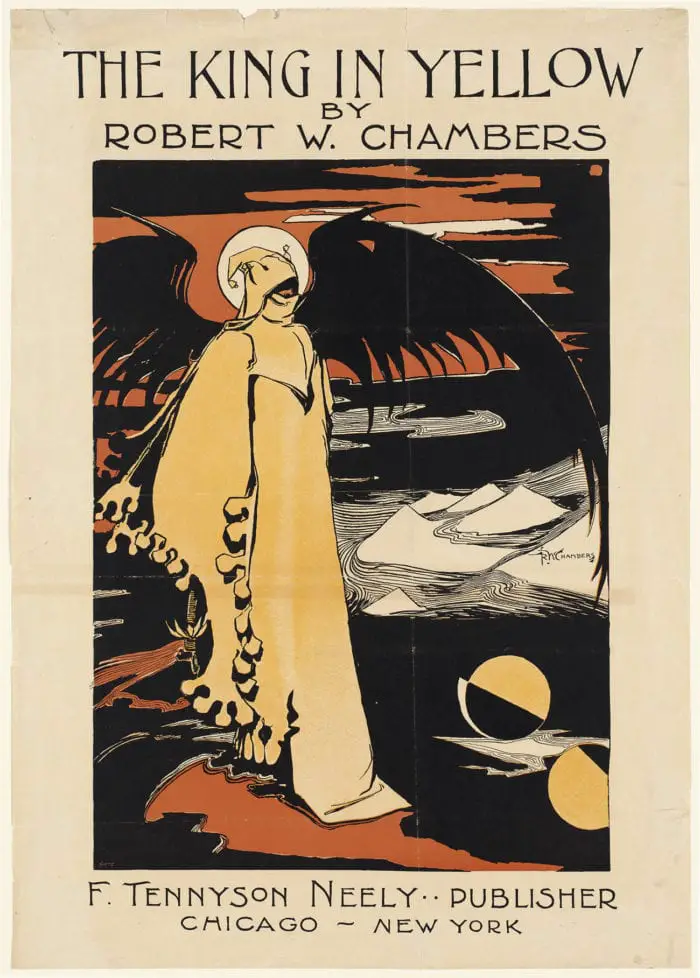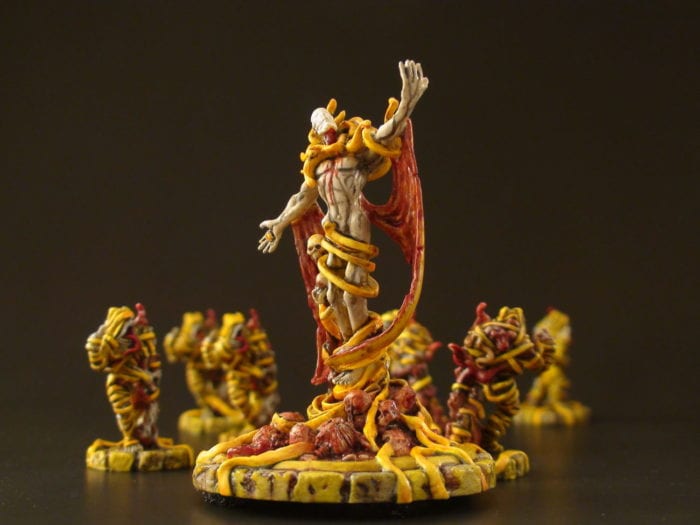The King in Yellow is a masterful collection of stories composed by Robert W. Chambers and first published in 1895. It comprises ten stories of varying lengths and levels of fright, ranging from short and intense to highly disturbing slow burns.
The premise revolves around a play published within the story of the book itself, also entitled The King in Yellow, that is so sublimely and terrifyingly profound that it drives its readers insane. What’s more…it is repeatedly hinted throughout the collection that the embodied source of this insanity is mystifyingly real and, let’s just say, not from around here.
If you’ve never heard of Chambers before, there’s a reason.
25 years before the great literary mastermind H.P. Lovecraft was born in Rhode Island, Chambers was born in New York. Though eminently talented, he was in the unfortunate position of having absolutely no idea what he wanted. Starting as an artist, he moved to Paris, where his work was featured in the Paris Salon and purchased by several magazines [1].
By all accounts, he was doing better than he had any right to expect when he inexplicably abandoned painting for writing horror. As it happened, he was surprisingly good, which only made it weirder when he recklessly dropped scary stories for eye-rolling romance novels. Lastly, and less bizarrely, Chambers gave up writing romance for historical fiction when the First World War began. At the time of his death in December 1933, he left behind a legacy much like a bag of trail snacks: tasty but mixed [2].

Of him, Lovecraft remarked,
Chambers is like Rupert Hughes and a few other fallen Titans—equipped with the right brains and education but wholly out of the habit of using them. [3]
Ouch.
Despite the rough treatment, it’s only thanks to Lovecraft that we are even speaking of Chambers at all. During his days of writing horror, he captured the attention of Lovecraft and his ilk with a splendid collection of stories entitled The King in Yellow.
Thoroughly impressed, he included The King in Yellow in Supernatural Horror in Literature, Lovecraft’s erudite examination of the genre [4]. In fact, there’s a good argument that Lovecraft’s signature style of slow and nebulous narration is directly inspired by Chambers. Going even further, Lovecraft partially incorporated The King in Yellow into his own Cthulhu mythos by way of several references. Without those inclusions, it is entirely possible that The King in Yellow would not have survived the ravages of time.
Fortunately for us, it has.
What follows is a prodigious literary danse macabre across several shadow-laden locations and tragic characters. The first four stories directly connect to each other in both theme and character, while the remaining six are independent.
Each story takes place within the same world and period of time, and though they feature different locations and characters, they all connect. Anyone familiar with the narrative style of the recent Marvel movies will understand this perfectly. A seemingly random name mentioned offhand by a character in the first story may be the protagonist of the third. The distant hometown of the protagonist in the second story may well be the main setting of the fourth, and so on. As such, The King in Yellow improves with repeated reads as one comes to see the grisly intricacy with which Chambers weaves his web.

The King in Yellow begins with “The Repairer of Reputations,” the longest story in the collection. This is partly due to the fact that it begins with a solid three pages of backstory establishing the time period for the rest of the book. Alongside the worldbuilding, “The Repairer of Reputations” opens with an excerpt from the King in Yellow play, giving us a peek into the nightmare pages that will torment us during the upcoming chapters.
“The Repairer of Reputations” follows the story of Hildred Castaigne, a young and semi-aristocratic man whose personality has been recently altered by an ill-timed head injury. Hildred is the very definition of the unreliable narrator archetype, and Chambers was one of the very first to employ it. Sometime shortly after his injury, Hildred reads a copy of The King in Yellow and descends into both lunacy and staggering neuroticism. His immediate associates are then cast into a world of psychotic danger as Hildred grows ever more violent and delusional. For its time, The Repairer of Reputations was starkly experimental and avant-garde. It still holds up very well today and is a brilliant opening note for the collection.
The second story within The King in Yellow is entitled “The Mask,” and whereas “The Repairer of Reputations” is long and gritty, this one is short and dream-like. It also begins with an excerpt from the King in Yellow play and features a man named Alec as the protagonist. Alec is friends with a young sculptor by the name of Boris and two other Paris-dwelling bohemians. Boris however is certainly not the average sculptor and is something of an alchemist, too. The four friends end up being exposed to The King in Yellow over the course of the story, and delirium-induced tragedy ensues. That being said, the ending of “The Mask” is actually quite positive for a horror story, so I won’t dare spoil it here.
Next is “In the Court of the Dragon,” the shortest and most intense of the first four stories. This time our narrator has no name and is merely described as something of a failed artist living in France. Our new friend is busy attending church when the story begins, though we soon learn he is there to seek comfort from unseen woes. Turns out, our protagonist has been doing some reading in The King in Yellow and is now suffering from some rather crippling paranoia. Because of how quickly the story moves, I can’t say much more without giving spoilers, but this is probably the most fun of the first four stories. In perfect contrast to the previous work which ends somewhat positively, the finale of “In the Court of the Dragon” is downright insane.
The last of the first four stories is called “The Yellow Sign,” and it takes place in New York. This time, our main character is a painter by the last name of Scott. Mr. Scott may be the most connected character in the entire collection as he seems to appear in three separate stories and is even aware of the events in a fourth. In “The Yellow Sign,” Scott is joined by his art model Tessie in a slow-burning tale of impending death and gloom. As the title suggests, the story largely focuses on The Yellow Sign, an oft mentioned McGuffin throughout the previous three tales. Just like Scott himself, “The Yellow Sign” is the most interconnected of the stories and brings a lot of previous hints and clues together. No wonder, as this is clearly the finale of the arc the first four stories create.

Indeed, when one is referring to The King in Yellow, one is typically speaking of the first four stories. The fifth and seventh are unrelated to the first four but are still spooky in their own right, while the sixth is no story at all. It is rather a collection of short poems which add much-appreciated lore to the first four stories and should really have been listed fifth instead of sixth. The eighth story isn’t horror per se but is certainly disturbing enough and will engender plenty of tension, if not fear.
The final two stories sadly have no relation to the previous eight and exit the realm of horror altogether, much as Chambers himself would do. Stories nine and ten are pleasant, though unremarkable, romances in Paris featuring a naive American protagonist. They are exactly what they sound like, and we are not here for that!
Still, the first four stories alone make reading the collection worth your while, and since it is entirely available within the public domain, you have nothing to lose. Once you’ve read the first four stories, you can make your own decision about going on, but I think you’ll wish to. I certainly did.
There are also several excellent audio versions available on Audible or even YouTube. My all-time favorite narrator, Ian Gordon, has an outstanding channel called Horrorbabble where he has narrated hundreds of great horror stories, including The King in Yellow and the nearly completed works of H.P. Lovecraft. If you do decide you’re interested in checking it out, his rendition is one of the best.
Alternatively, I myself have recorded a complete audio version of The King Yellow, which is available on Audible.
In the end, if you like Lovecraft, you’ll like Chambers too, at least to the extent that he writes horror. For those of us who have already read or listened to every scrap of Lovecraft available, The King in Yellow is a chilling and sinister way to get your fix.
[1] “Robert Chambers, Novelist, Is Dead,” The New York Times, December 1933, p. 36.
[2] Jonathan Nield, “A Guide to the Best Historical Novels and Tales,” in A Guide to the Best Historical Novels and Tales (New York, NY: B. Franklin, 1968), pp. 91-114.
[3] H. P. Lovecraft et al., “Selected Letters Vol II.,” in Selected Letters Vol II. (Sauk City, WI: Arkham House, 1968), p. 148.
[4] H. P. Lovecraft, Supernatural Horror in Literature. With a New Introd. by E.F. Bleiler (New York: Dover Publications, 1973).




If you enjoyed my perspective here on Horror Obsessive, then please consider listening to my Podcast on a very different subject.
I’m the host of Modernist Monastery, it’s about the connection between ancient philosophical or spiritual practices and modern scientific research. It’s also a show about how to apply that connection to your everyday life
https://modernistmonastery.transistor.fm/